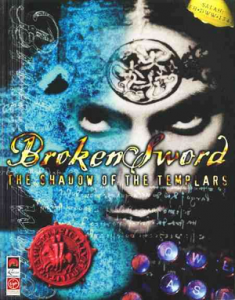312th played so far
 Genre: Adventure
Genre: Adventure
Platform: PC/PlayStation 1
Year of Release: 1996
Developer: Revolution Software
Publisher: Virgin Interactive/SCEE
While last time’s Pac-Man was a game we’d played because, well, everyone had played it, Broken Sword is a bit more of a coincidence. One of us had the PC version, the other Playstation, and we both got far in it (I think I even finished it. I got stuck in the Syria section).
An adventure in the LucasArts mold, Broken Sword takes you on a more serious adventure (though not too much so) following in the footsteps of… well… the Templars.
Our Thoughts
This game’s start alone is memorable. While the main character, George Stobbart, is having a drink at a cafe, a clown rushes past inside. Moments later, a bomb goes off inside the cafe and our hero starts his investigation into what happens – leading him from Paris (where the game starts) to Ireland, Spain, Syria and further abroad.
The story underlying these journeys is interesting, as is appropriate for a game like this. The story takes templar history and many of the conspiracy theories surrounding them, linking it into many of the interesting characters you meet along the way.
And the writing for them is good. While some start off from a cliched place (and a number of the smaller characters stay there), they feel quite well rounded. Almost all are nicely written into the plot, while feeling like more than just ‘puzzle-givers’ – they have opinions and comments on more than just the bit they’re concerned with.
The puzzles themselves are mostly sane, with few really not making any sense. The main problem here tends to be its reliance on the small areas that can be impossible to click at times unless you really go pixel hunting. It took me quite a while to figure out you pick up a piece of cloth the first time because it was too small for sweeps of the screen to find it, while later stealing some pieces of wire for a trap can almost only be done when you know what you’re doing. And then there’s the infamous goat’s puzzle. It’s possible to get it to the right place, it makes sense that what happens to it… happens, but the process is too fiddly to really make sense.
The main problem that I remember having with Broken Sword was that the Playstation version was still a mouse-oriented point-and-click game rather than something more controller friendly. This meant time sensitive puzzles took multiple attempts and that I had to do a lot of pixel-hunting to find solutions. It was a lot easier (and enjoyable) to play this again on the PC some 15 years later.
The graphics themselves are gorgeous. The style is a bit simple at times, with an intentionally cartoonish bent (making George look like far less of a hunk than he’s meant to be). There’s quite a bit of character in them though, which makes a lot of the characters even more recognisable and add to the personality we mentioned earlier. It makes them a lot more inviting.
Then there’s the voice acting. While most of it is good, with the main character especially bearable considering how often you listen to George, some of the French accents turn a bit too over the top and are exaggerated to the point of distraction, at times when the game is meant to be serious. You sort of get used to it, but a bit less would have been welcome.
Final Thoughts
The game draws you in far enough that it is entirely suitable for marathon sessions of adventuring – for the blog, I believe Peter finished it in two or three 3-4 hour sessions (It was awesome.)
The puzzles are clever and not too difficult, while the story is involving enough to keep playing. Probably one of the top series of its kind.
[…] Vu is an early one that does so. I’ve seen bits of it, and it isn’t full on like, say, Broken Sword, but we’re moving on from having to use your imagination like you would do in Zork. I have […]
[…] know Revolution Software’s games mostly from the Broken Sword series, of which I’ve played the first four and backed the fifth – I still need to play […]